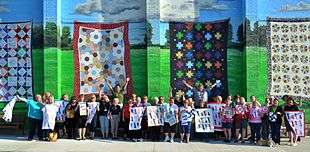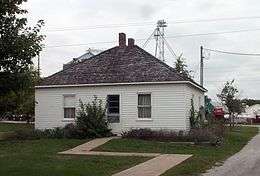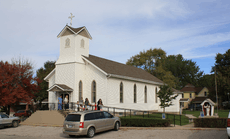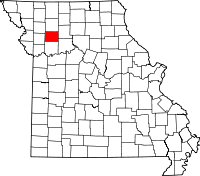Hamilton, Missouri
| Hamilton, Missouri | |
|---|---|
| City | |
 Location of Caldwell County | |
| Coordinates: 39°44′38″N 93°59′56″W / 39.74389°N 93.99889°WCoordinates: 39°44′38″N 93°59′56″W / 39.74389°N 93.99889°W | |
| Country | United States |
| State | Missouri |
| County | Caldwell |
| Area[1] | |
| • Total | 1.41 sq mi (3.65 km2) |
| • Land | 1.40 sq mi (3.63 km2) |
| • Water | 0.01 sq mi (0.03 km2) |
| Elevation | 988 ft (301 m) |
| Population (2010)[2] | |
| • Total | 1,809 |
| • Estimate (2012[3]) | 1,743 |
| • Density | 1,292.1/sq mi (498.9/km2) |
| Time zone | Central (CST) (UTC-6) |
| • Summer (DST) | CDT (UTC-5) |
| ZIP code | 64644 |
| Area code(s) | 816 |
| FIPS code | 29-30034[4] |
| GNIS feature ID | 0719026[5] |






Hamilton is a city in Caldwell County, Missouri, United States. The population was 1,809 at the 2010 census. It is known as the hometown of James Cash Penney, the business entrepreneur and philanthropist, and the hometown of Jenny Doan who has built a large quilting-related business called Missouri Star Quilt Co.[6]
History
Hamilton, Missouri owes its existence largely to the Hannibal & St. Joseph Railroad.[7] Prior to 1854 the area around Hamilton was unsettled prairie land belonging to the U.S. Government. With the coming of the railroad, the Hamilton Town Company was formed to develop a tract of land along the rails. At first the name Prairie City was intended for the new community.[7] However Albert Gallatin Davis, a key member of the Town Company, chose Hamilton instead, in honor two early Americans, Founding Father and first Treasury Secretary Alexander Hamilton, as well as Joseph Hamilton, a notable early American lawyer and military leader killed at the Battle of the Thames during the War of 1812.[8][9] The first house in Hamilton, fittingly, was built by Mr. Davis in the summer of 1855 as well as the first business, a general store, in 1857. The store would serve as Hamilton's first Post Office and Davis the first Postmaster in 1858.[7] The Hannibal & St. Joseph was finally completed on Valentine's Day, February 14, 1859 and it proved a sweet day indeed for Hamilton as the first train arrived that day as well. A railroad depot was constructed by Fall, 1859 with Albert Gallatin Davis appointed the first railroad and express agent.[7] By the outbreak of the American Civil War, Hamilton consisted of about 25 homes and businesses. The town saw little involvement in the war, despite northwest and northcentral Missouri being a hotbed of guerrilla warfare. The majority of the towns residents held strong pro-Union sympathies, with the few pro-Confederates among the populace forced to take an oath of allegiance[7] Being on the rail line made Hamilton a tempting target for Confederate "bushwhackers", so beginning in Fall, 1861 a company of the 50th Illinois Infantry arrived to help the local Home Guard unit defend the town.
Once the war ended Hamilton experienced a period of rapid growth and was finally incorporated in 1868.[10] At that time several new sections of land had been annexed into the original town plat and the population grew to several hundred. After a brief slowdown caused by the Panic of 1873 growth resumed and by the mid-1880s Hamilton featured two newspapers—the Hamiltonian and the News-Graphic—as well as two banks, two hotels, flour mills, grain elevators, and numerous other businesses supported by a population of around 1,800.[7] Coal mining became of some importance to the towns economy in the early 1880s. The Hamilton Coal Company was organized in Spring, 1882 and began mining operations the following year about two miles outside of the town. A railroad spur line was constructed to connect the coal field to the Hannibal & St. Joseph main line.[7]
Town of champions
Penney High School, Hamilton, named in honor of the towns most famous native, has won several Missouri state sports championships. The boys won in football three times, and also placed at the state level in basketball, track and field, and golf.[11][12] The girls won the state track and filed championshiip five years in a row, from 2007 through 2011, and won the basketball championship twice. The girls softball team also placed in state competition.
Kellen Overstreet, a running back for Penney High School football team from 2012 to 2015, was chosen as a first-team all American by Parade Magazine.[13]
A Quilter's Destination
Missouri Star Quilt Company has recently made Hamilton a national tourist destination for quilters. It was founded by the Doan siblings in support of their mother Jenny Doan's dream, and in tribute to her talent as a quilter made famous on YouTube. It has grown into a $20,000,000 per year business which owns 21 buildings in Hamilton and is part owner of three restaurants. MSQC also publishes a bi-monthly magazine called BLOCK. It brings as many as 3,000 quilters to Hamilton in a month, and has helped to transform the small town into a veritable quilter's paradise, with 12 new quilt shops and a sewing center for quilting retreats.
In seven years, Missouri Star became the largest employer in Caldwell County, with over 200 employees. Because of this, the siblings who put their mother on the map with the help of business expertise were in 2015 named the Missouri Small Business Persons of the Year,[14] and designated by the federal government's Small Business Association the national Small Business Persons of the Year.[15][16]
Geography
Hamilton is located at 39°44′38″N 93°59′56″W / 39.74389°N 93.99889°W (39.743791, -93.998765).[17]
According to the United States Census Bureau, the city has a total area of 1.41 square miles (3.65 km2), of which, 1.40 square miles (3.63 km2) is land and 0.01 square miles (0.03 km2) is water.[1]
Demographics
| Historical population | |||
|---|---|---|---|
| Census | Pop. | %± | |
| 1870 | 975 | — | |
| 1880 | 1,200 | 23.1% | |
| 1890 | 1,641 | 36.8% | |
| 1900 | 1,804 | 9.9% | |
| 1910 | 1,761 | −2.4% | |
| 1920 | 1,689 | −4.1% | |
| 1930 | 1,572 | −6.9% | |
| 1940 | 1,655 | 5.3% | |
| 1950 | 1,728 | 4.4% | |
| 1960 | 1,701 | −1.6% | |
| 1970 | 1,645 | −3.3% | |
| 1980 | 1,582 | −3.8% | |
| 1990 | 1,737 | 9.8% | |
| 2000 | 1,813 | 4.4% | |
| 2010 | 1,809 | −0.2% | |
| Est. 2015 | 1,711 | [18] | −5.4% |
2010 census
As of the census[2] of 2010, there were 1,809 people, 719 households, and 460 families residing in the city. The population density was 1,292.1 inhabitants per square mile (498.9/km2). There were 802 housing units at an average density of 572.9 per square mile (221.2/km2). The racial makeup of the city was 98.3% White, 0.2% Native American, 0.1% Asian, 0.2% from other races, and 1.2% from two or more races. Hispanic or Latino of any race were 1.0% of the population.
There were 719 households of which 34.4% had children under the age of 18 living with them, 46.2% were married couples living together, 13.6% had a female householder with no husband present, 4.2% had a male householder with no wife present, and 36.0% were non-families. 32.8% of all households were made up of individuals and 14.9% had someone living alone who was 65 years of age or older. The average household size was 2.44 and the average family size was 3.08.
The median age in the city was 38.1 years. 28.7% of residents were under the age of 18; 7% were between the ages of 18 and 24; 22.4% were from 25 to 44; 23.5% were from 45 to 64; and 18.4% were 65 years of age or older. The gender makeup of the city was 47.4% male and 52.6% female.
2000 census
As of the census[4] of 2000, there were 1,813 people, 744 households, and 482 families residing in the city. The population density was 1,327.9 people per square mile (511.0/km²). There were 829 housing units at an average density of 607.2 per square mile (233.6/km²). The racial makeup of the city was 98.62% White, 0.11% African American, 0.06% Native American, 0.06% Asian, 0.06% from other races, and 1.10% from two or more races. Hispanic or Latino of any race were 0.44% of the population. There were 744 households out of which 32.1% had children under the age of 18 living with them, 49.7% were married couples living together, 10.9% had a female householder with no husband present, and 35.2% were non-families. 31.7% of all households were made up of individuals and 18.7% had someone living alone who was 65 years of age or older. The average household size was 2.36 and the average family size was 2.98.
In the city the population was spread out with 27.0% under the age of 18, 7.7% from 18 to 24, 24.2% from 25 to 44, 18.5% from 45 to 64, and 22.7% who were 65 years of age or older. The median age was 38 years. For every 100 females there were 85.0 males. For every 100 females age 18 and over, there were 80.6 males.
The median income for a household in the city was $25,972, and the median income for a family was $32,560. Males had a median income of $26,250 versus $17,083 for females. The per capita income for the city was $14,484. About 13.4% of families and 16.1% of the population were below the poverty line, including 20.8% of those under age 18 and 20.3% of those age 65 or over.
Notable natives

- James Cash Penney, founder of J.C. Penney (his farm home has been moved to town and is a museum). There is a separate J.C. Penney Memorial Library & Museum in town.
- Jenny Doan, quilter
- Kellen Overstreet, Parade First-team All-American 2015
- Lindsay Vollmer, NCAA Heptathlon Champion, 2013 National Outdoor Championships
- Zack Wheat, National Baseball Hall of Fame and Museum ballplayer (in 2006 Route 13 was named the Zack Wheat Memorial Highway)
Gallery
| Churches in Hamilton Missouri Select to enlarge | ||||||||||
|---|---|---|---|---|---|---|---|---|---|---|
|
References
- 1 2 "US Gazetteer files 2010". United States Census Bureau. Retrieved 2012-07-08.
- 1 2 "American FactFinder". United States Census Bureau. Retrieved 2012-07-08.
- ↑ "Population Estimates". United States Census Bureau. Retrieved 2013-05-30.
- 1 2 "American FactFinder". United States Census Bureau. Retrieved 2008-01-31.
- ↑ "US Board on Geographic Names". United States Geological Survey. 2007-10-25. Retrieved 2008-01-31.
- ↑ http://www.wsj.com/articles/SB10001424052702303277704579349133544709954
- 1 2 3 4 5 6 7 'History of Livingston and Caldwell Counties, Missouri. Higginson Book Company. 1886. pp. 345–355.
- ↑ "Our History-Hamilton". Caldwell County Development Group. 2010. Retrieved 24 November 2012.
- ↑ Eaton, David Wolfe (1916). How Missouri Counties, Towns and Streams Were Named. The State Historical Society of Missouri. p. 266.
- ↑ "City Data Hamilton, Missouri". City Data.com. 2012. Retrieved 24 November 2012.
- ↑ "Missouri High School football scores, 11-23-12". Associated Press via KTVO-TV website. 23 November 2012. Retrieved 24 November 2012.
- ↑ "MSHSAA Girls Basketball Championship History" (PDF). Missouri State High School Activities Association. 2007. Retrieved 24 November 2012.
- ↑ Parade. Accessed 11 October 2016.
- ↑ Missouri award. Accessed 16 October 2016.
- ↑ US Small Business Administration. Accessed 16 October 2015.
- ↑ Inc.com Accessed 16 October 2016.
- ↑ "US Gazetteer files: 2010, 2000, and 1990". United States Census Bureau. 2011-02-12. Retrieved 2011-04-23.
- ↑ "Annual Estimates of the Resident Population for Incorporated Places: April 1, 2010 to July 1, 2015". Retrieved July 2, 2016.
- ↑ "Census of Population and Housing". Census.gov. Retrieved June 4, 2015.
External links
- Historic maps of Hamilton in the Sanborn Maps of Missouri Collection at the University of Missouri





